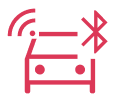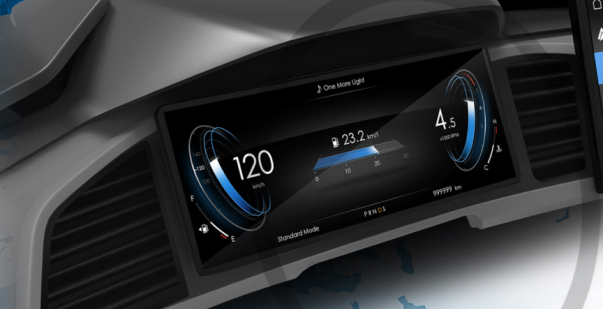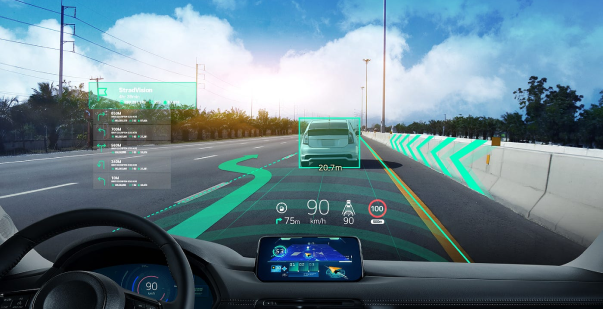Intuitive interfaces. Insightful analytics. Innovative thinking
DIGITAL COCKPIT SOLUTIONS Intuitive interfaces. Insightful analytics. Innovative thinking
OVERVIEW
The automotive landscape observes a transformation with the emergence of software-defined vehicles. The traditional cockpit with buttons and dials has evolved into an integrated digital ecosystem of screens, input devices, and seamless connectivity – now known as the digital cockpit. The global automotive digital cockpit market size, valued at USD 19.8 billion in 2020, might expand at a CAGR of 8.8% over 2021-2028.
At People Tech Group, we spearhead Automotive Innovation through our Digital Cockpit platform, which aims to deliver superior in-vehicle experience. We support the integration of ECUs (electronic control units) and domain consolidation, including cluster and cockpit, AR-HUD, infotainment, rear seat displays, e-Mirror, and in-cabin monitoring services. We leap our expertise to the advanced Front and Rear command consoles too.
The Digital Cockpit primarily hinges on a trio of functional components: sophisticated computing hardware, advanced processing software, and an array of sensitive sensors. The new automotive system consists of integrated and complex components that need advanced and powerful SoCs to deliver the desired results. Here at People Tech, we bring together the best components to provide the future of driving today.
- Architecture of a Digital Cockpit
- Obstacles in HMI
- Solutions – Advanced HMI
Functional Components
Infotainment System
Infotainment Systems Enabling Next-Generation Connected Car Features

V2X FEATURS

TELEMATICS

IN-CAR
COMMERCE

IN-VEHICLE
PAYMENT SERVICES

SDV APPLICATIONS

VIRTUAL ASSISTANT

ADAPTIVE HMI
Integrated Instrument Cluster

Integrated Instrument Cluster

Heads-Up Display (HUD)

Smart HVAC (Heating, Ventilation, and Air Conditioning) Systems

Rear Passenger Entertainment
Supporting Components
Compute Components
Software Components
Android Automotive OS
Virtualization Hypervisor
Obstacles in HMI
Core Automotive HMI
We build cohesive and expansive HMI design blueprints tailored to your brand’s identity. This stretches from initial concepts to manufacturing-ready UI screens and in-vehicle technologies. The design process analyzes competition, explores UI architectures and driver profiles, and hosts visual design workshops. We define the design intent, refine UI structures, and validate experiences through user testing.
Customer Centric – Interactive HMI
Enhancement of Incumbent HMI
Solutions – Advanced HMI
The in-vehicle interface that allows drivers to interact with vehicle features is rapidly evolving. Technological strides, evolving customer expectations, and the expanding connected and autonomous vehicle sector are propelling the automotive HMI industry toward innovations.
HMI serves as the conduit to entertainment, safety, and connectivity features, crucial for establishing driver comfort with autonomous driving capabilities. Effective HMI design plays a pivotal role in making drivers comfortable with self-driving elements.
However, achieving optimal HMI functionality is a complex task, demanding a nuanced grasp of emerging technologies and design principles. While the primary goal is to augment driver safety and improve the overall experience, excess features in the car’s cockpit can prove counterproductive.
Challenges in HMI design include accommodating regional variations, swiftly and cost-effectively implementing updates, and educating drivers to enhance feature adoption. Navigating these challenges is crucial to unlocking the full potential of automotive HMI and ensuring its seamless integration into the future of smart, connected vehicles.
At PTG, we aim to craft intuitive and user-friendly digital cockpits for modern vehicles. Through our human-centric design approach, we create immersive driver experiences that prioritize safety while offering personalized control. Our design principles revolve around multimodality, safety and personalization.
We enable diverse natural inputs like touch, voice, gestures and haptics so that drivers can interact seamlessly without getting distracted. Advanced speech recognition allows hands-free voice commands even in noisy environments. In-cabin cameras facilitate gesture controls for eyes-free operation. Additionally, we employ adaptive interfaces that continuously learn driver preferences to provide a tailored experience.
Through collaborations with major automotive manufacturers, we have helped transform in-vehicle human-machine experiences ranging from voice-based climate control to gesture navigation systems and gamified 3D interfaces. Our user-first ideology focuses on crafting technology that seamlessly augments human capabilities for the next frontier of mobility.
Investing with PTG today means staying ahead of the automation competition, representing the joy of driving with the utmost offerings at your fingertips. We invite you to navigate this journey with an innovative partner who shares your vision of transforming vehicles into intelligent mobility solutions.
